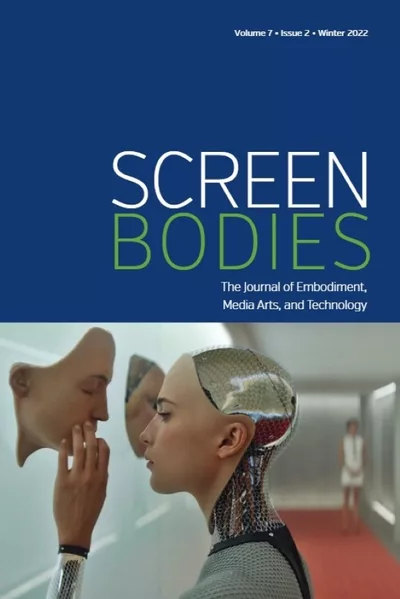
Screen Bodies
The Journal of Embodiment, Media Arts, and Technology
ISSN: 2374-7552 (print) • ISSN: 2374-7560 (online) • 2 issues per year
Latest Issue
Volume 10 Issue 1
Theory of the Digital Body
Narrative, Performance, and the Self
This is the tenth year of
“I Feed You My Limbs”
Haunting and Hunger in Sally Wen Mao's “Live Feed”
On social media sites, both digital bodies and user to user experiences continuously destabilize the binaries life/death (or living/dead). The slippage of life/death digital social media members experience is made particularly salient in Sally Wen Mao's poem “Live Feed.” In the poem, the unnamed speaker is a personified piece of uploaded information—a nonliving actant—circulating in a social network's live feed, the place where information is devoured. I define this experience as “zombie hunger” as it applies to digital social network use and develop better language to trace self-representation on Facebook and Instagram and the material, embodied, and laboring human/nonhuman forces that allow for this body of knowledge to be accessible.
Dreaming in Blue
The Autopoetry of Inès Bouallou
This article examines some of the self-portraits that Inès Bouallou, a young, Moroccan autodidact, has posted to Instagram. Bouallou sometimes calls her posts “autopoetry,” arguably one of autotheory's related genres. Through the lens of autotheory, which couples autobiography with theory, this article analyzes three features of Bouallou's autopoetic practice. She often cites literature alongside her self-portraits, thereby creating a dialogue between others’ words and her own life. In addition, Bouallou's self-portraits stage performances that put the self's coherence and stability into question. Finally, her photographs depict provocative instances of self-care, moments when the artist takes care of another incarnation of herself. Ultimately, this article aspires to inform autotheorists and others in the Global North of a comparable practice in North Africa.
Border Screen(ings), Or How to Undocument a Body
The spectacle of war in the US-Mexico border is ubiquitously projected onto the screens that mediate our daily life, so that the screen (and the process of screening) becomes part of the discourses and material conditions of colonial capitalism, structuring our relationships with our and Other bodies. Xandra Ibarra's video performance in
Experiment No. 27
Experiment No. 27 and others are each multiscreen choreographic components of the installation
Moving Beyond the Spear
Kelly Reichardt and Ursula K. Le Guin in Dialogue
This article explores Kelly Reichardt's
The Impact of COVID-19 on HBO's Westworld Season 4
The Rejection of the Posthuman Body
Although
Playing with Memory
Neurogames as a Means of Preserving Selfhood in Alzheimer's Disease
Alzheimer's Disease (AD) is a condition that results in the slow deterioration of a person's memories and eventually their cognitive function. As this condition is so feared, there are several stigmas surrounding the disease. This article focuses on how neurogames, games that focus on neurological conditions where players play as either the patient themselves or alongside them and are developed for educational and entertainment purposes, may help address these stigmas and provide new means for expressing selfhood and consciousness.
Substances in Play
The Game Body and Silent Hill 2
This article examines Timothy Crick's notion of the game body, thinking beyond the visuality that defines cinematic “film body,” an embodied subject–object that mediates the sensation of a film to the viewer. Examining
Kara Walker's Uncanny Valley in Fortuna and the Immortality Garden (Machine)
This exhibition review of Kara Walker's
Book Review
Violet Lucca,